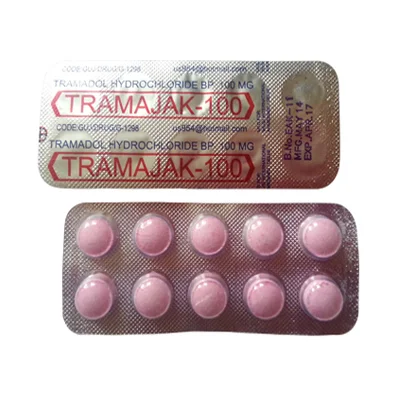Description
Tramadol 100 mg (Extended-Release Tablets)
Overview
Tramadol 100 mg is a prescription pain-relief medication (analgesic) used to manage moderate to moderately severe pain in adults. It belongs to the opioid analgesic class but has a dual mechanism of action, providing both opioid-like pain relief and non-opioid activity that enhances comfort and pain tolerance.
Tramadol is available in both immediate-release and extended-release (ER) formulations. The 100 mg dose is typically prescribed as the extended-release form for continuous, around-the-clock pain control.
Key Details
-
Generic Name: Tramadol Hydrochloride
-
Brand Names: Ultram®, ConZip® (brand names vary by region)
-
Strength: 100 mg (commonly extended-release)
-
Dosage Form: Oral tablet or capsule
-
Drug Class: Opioid Analgesic
-
Manufacturer: (Varies by region)
-
Prescription Required: ✅ Yes
-
Controlled Substance: Schedule IV (in many regions – lower abuse risk than stronger opioids)
How It Works
Tramadol provides pain relief through two main mechanisms:
-
Opioid Receptor Activation: It binds to mu-opioid receptors in the brain and spinal cord, reducing pain perception.
-
Neurotransmitter Reuptake Inhibition: It inhibits the reuptake of serotonin and norepinephrine, neurotransmitters involved in the body’s natural pain control pathways.
This dual action makes Tramadol effective for a broad range of pain conditions — including chronic musculoskeletal pain, post-surgical pain, and neuropathic pain.
Usage Guidelines
-
Take Tramadol 100 mg exactly as prescribed by your healthcare provider.
-
The extended-release tablet should be taken once daily, at the same time each day.
-
Swallow whole — do not crush, chew, or split.
-
Can be taken with or without food, but consistency helps maintain even absorption.
-
Do not exceed the prescribed dose, as this may increase the risk of seizures or respiratory depression.
-
For patients new to Tramadol, doctors usually start with a lower dose and gradually increase if needed.
Safety Information & Precautions
-
May cause drowsiness, dizziness, or impaired coordination — avoid driving or operating heavy machinery after taking.
-
Do not mix with alcohol, sedatives, or other opioids, as this can cause serious or fatal side effects.
-
Inform your doctor if you have breathing problems, seizures, liver or kidney disease, depression, or a history of substance abuse.
-
Tramadol may cause dependence or withdrawal if used for a long time or stopped suddenly.
-
Use with caution in elderly patients or those taking antidepressants, as serotonin syndrome (a rare but serious reaction) can occur.
-
Pregnant or breastfeeding women should use only under medical advice.
Possible Side Effects
Common side effects include:
-
Drowsiness or dizziness
-
Nausea or vomiting
-
Constipation
-
Sweating or flushing
-
Dry mouth
-
Headache
Serious side effects (seek immediate medical attention):
-
Slow or difficult breathing
-
Confusion or hallucinations
-
Seizures
-
Signs of serotonin syndrome (agitation, high fever, rapid heartbeat, muscle stiffness)
-
Signs of allergic reaction (rash, swelling, difficulty breathing)
Storage Instructions
-
Store at room temperature (20–25 °C / 68–77 °F)
-
Keep away from heat, moisture, and direct sunlight
-
Store in a locked and secure place, away from children or pets
-
Dispose of unused or expired tablets through a drug take-back program — do not flush down the toilet






Reviews
There are no reviews yet.